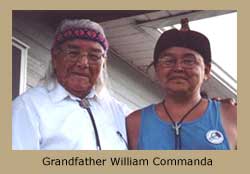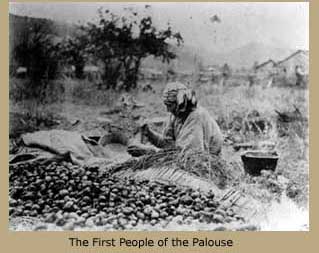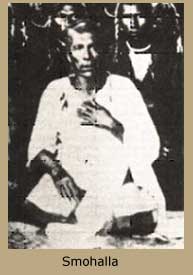 |

Basic Call to Consciousness

Intention

Invented White
History & Imagery

In the Beginning

First Nations Governance

Trail of Tears

Tragedy of
Little Bighorn

Massacre at
Wounded Knee

Duwamish/Suquamish
Displacement

Cultural Genocide

Native Values

Impact of European Immigrants

The Take-over

Called ‘Indian’ or....

Cultural Genocide - Boarding schools

Native Values &
Way of Life

Morality

Depression &
Substance abuse

Cultural Distinctions

Spiritual Sensibilities

Language

Living Two Lives

Leaders or Rulers

Written or Oral

Painful History

Iroquois Conservation

Chief Seattle’s
Farewell Speech

Spirit Road

|
 |

What We’re Called - Indian? or....
Lakota Elder continues: “Some Indians decided they would rather be called Native Americans. But some say that’s no more real than Indians, because, to some of us, this isn’t even America. Someone was lost and thought they landed somewhere else. It’s like if someone took over this country, now, and called it, say, Greenland, and then they said that those of us who were already here are going to be called Native Green landers. And they said they were doing this out of respect. Would you feel respected? That’s what we put up with every day-people calling us a bunch of names that aren’t even real and aren’t even in our language. We had our identities taken from us the minute Columbus arrived in our land.’

 This statement was expressed almost verbatim about three years earlier in Profiles in Wisdom authored by Steven McFadden interviewing Native Elder, Grandfather William Commanda of Maniwaki Reserve in Quebec- born 1913.
This statement was expressed almost verbatim about three years earlier in Profiles in Wisdom authored by Steven McFadden interviewing Native Elder, Grandfather William Commanda of Maniwaki Reserve in Quebec- born 1913.

Grandfather’s statement: “Later, after the Vikings, when the other European immigrants got here, we were already millions of inhabitants in this country. But they seem to want to refuse to believe today that we were the first occupants, and that we have the claim of first occupancy....He, Columbus, didn’t arrive to find us. He was trying to get to India but he got lost. We found him!

Grandfather William Commanda continues: Algonquin means First People, but that is a name that has been given to us. We are the Mamiwinini, which means nomad, which we are. That’s our name. We had that name because we were not settled. We were wanderers; we hunted and fished and moved about.”
Cultural Genocide & Extinction Attempts
Lakota elder continues: “The European immigrants attempted to exterminate our culture with laws, with all kinds of censuses and regulations with forced relocation onto barren land. They mixed us up with white people. They took away our language and our religion and forced or bribed Christian indoctrination. They took our kids away from their families to schools far away and wouldn’t let them learn about the old culture. Children in the schools were beaten if caught speaking their own language to each other. They herded us onto reservations and rewarded Indians who acted just like white people. They were attempting to create a generation of Indians who didn’t know who they were. If we don’t fight for who we are we will be destroyed by false ideas and phony Indians and all the intentions of people who think they are helping us by making us act like white people.

Lakota elder continues: “Long hair was the way of my people before the white man. We grew it long because it is part of nature and because it shows our pride. If something bad happened in our lives, or if we disgraced ourselves, we cut it off. We grew it back when we wanted to show our pride again. A lot of our people still keep to this old way. The white people forced us to cut our hair. When they sent us to boarding school, that was the first thing they did to us-they cut our hair off.”

Repeatedly, Native stories tell of the federal government’s intentional breakdown of their cultures. Men accustomed to lives as nomadic hunters, warriors, and shamans no longer had meaningful roles to play. These were proud men when living their natural life--you could see it in their faces. Instead of a natural, healthy diet of gathered plants, and hunted meat, and herbal medicines Natives were accustomed to feed their families, the women were rationed white flour - which had not been a part of their diet-, sugar, coffee, beef, and, maybe, beans. The People became sick. They contracted diseases from the white man causing countless deaths.

Native religious practices were outlawed. Dominant culture knowingly issued alcohol along with smallpox-infested blankets to the People. These were intentional acts of racism, oppression -- hatred toward a people--a culture who was native to the land. The intention was genocide of a people to afford the arriving immigrant settlers--dominant culture--their pick of the choicest land as well as access to gold or cotton discovered on Native land. Furthermore, the agents assigned to care for The People were often corrupt, selling the Native people’s supplies or getting them drunk for their own profit.

Across much of what is now called middle America, the Buffalo was sacred to the First People whose very existence was owed to this special creature of nature.


The Plains Peoples’ attitude of reverence toward the buffalo was also conveyed to all living creatures in all worlds--animal, plant and mineral. The People perceived that buffalo ‘gave of themselves’ so that their people might live...they used every part of the animal. Lame Deer explains: “That animal was like a part of ourselves; the buffalo gave us everything we needed--our tipis were made of his skin, his hide was our bed, our blanket, our winter coat, our drum, our waterbag. Nothing was wasted--the horns were our spoons, bones--our knives & women’s awls, hoofs were rattles....When you killed the buffalo you also killed the Indian, the real natural Indian.”

This world view also understood by Northwest & Alaskan Natives toward the Salmon. This attitude of gratitude and honoring was instilled in First People whose lives were intertwined with the buffalo, the Salmon - the resources supporting all of life...and, today, with pollution and dams negatively impact Salmon. White immigrants, not long after their arrival, killed off the buffalo in short order. Will the salmon experience the same demise?

History of the buffalo/bison--Before northern Europeans settled North America, there were an estimated 30-70 million bison ranging across the continent, from Alaska to at least the northern tier of Mexican states. The oldest herd fossils remaining in the lower 48 states are more than 100,000 years old.

An important archaeological site in New Mexico, the Folsom Site, revolutionized American archeology. It was the first time that irrefutable evidence of human tools and Ice Age animals were found together. The site proved to be a bison kill, or bison jump, where Paleo-Indians killed and butchered 23 bison nearly 10,000 years ago.

Once the mighty herds stretched in numbers beyond the horizon. To the First Peoples, before the arrival of Europeans, these animals provided an unending supply of food and raw material for tools, clothing and other products sustaining their lives. Also, the bison were considered spiritual beings that sustained the spirit as well as physical life.

To the early European explorers, the bison represented boundless wealth and potential for personal profit and freedom. That great wealth was almost completely wasted within a few decades by careless slaughter for fun and sport, and excessively exploitative hunting of bison for hides and tongues.

By 1889, less than 1,000 bison were left thanks to greed and lack of respect for life and living creatures by the white settlers, an attitude and strange way of living that the People Native to this land could not understand and were horrified by!

We are told that although a few families held to the old ways, many more families were torn apart by the shift of a foreign and strange way of living in which alcohol seemed to offer a solution to the pain of desecration of their long-held ways of life and values.

Not until the passage of the Indian Freedom of Religion Act passed by Congress as recently as 1978 finally reversing the law whereby the Federal government had outlawed Native spiritual and ceremonial practices. Indigenous religious practices had been made a federal offense by the white government in the late 19th century in order to suppress a culture and way of life of a conquered people--how does that hold up in the face of our Constitution --designed by immigrants who, themselves, were seeking religious freedom and personal liberty? And, it took until 1978 to reverse such a ruling.

In Messengers of the Wind, an elder woman of Dakota tribe informs: “Our ancestors were in different parts of the state, Dakota, for many hundreds of years. When the white people came west and wanted land, the government bought up a whole strip of land to the tune of 21 million acres. Then they gathered up all the Indians and resettled them somewhere else in 1851. They had to live on 10 acres on each side of what is now called the Minnesota River. They were expected to stay there and farm like white men. Whites wanted them to be in one place, not to roam around. Our people were not farmers. By 1861 they were restless. They could not get out and hunt, they couldn’t go fishing and ricing on the old sites as was our custom.”

An Ojibway woman confirms: “The Dawes Allotment Act passed in 1887 chopped up tribal land into small plots. Indians were supposed to become farmers subscribing to private land ownership. They had been used to moving with the seasons in search of wild game, fishing, ricing and planting, sharing what nature provided.
|
 Prior to Euro-american settlement, the Palouse River drainage was inhabited primarily by the Palouse people. The Nez Perce people spent much of their time in the southern part of the Palouse Prairie, its northern fringes were used by the Coeur d'Alenes and Spokanes, and the Cayuses used the area to the southwest. These patterns were fluid, however, with much overlap between the different groups. The annual cycle of hunting and gathering tracked seasonal changes in plant productivity. The cycle began with gathering roots at low elevations in spring; as the seasons progressed, plant and animal resources were harvested at progressively higher elevations.
Prior to Euro-american settlement, the Palouse River drainage was inhabited primarily by the Palouse people. The Nez Perce people spent much of their time in the southern part of the Palouse Prairie, its northern fringes were used by the Coeur d'Alenes and Spokanes, and the Cayuses used the area to the southwest. These patterns were fluid, however, with much overlap between the different groups. The annual cycle of hunting and gathering tracked seasonal changes in plant productivity. The cycle began with gathering roots at low elevations in spring; as the seasons progressed, plant and animal resources were harvested at progressively higher elevations.
|
However, the idea of dividing the land into individual plots and owning the land was totally alien to them. Before long, through legal maneuvers, swindles, and sales agreements of questionable legitimacy, European immigrant settlers had obtained the best land on almost all the reservations in the country.

Lakota elder continues: “Your people took all our Indian land and gave it back to us in squares and said to us Indians: You now have the freedom to be farmers and ranchers. We didn’t want to be farmers and ranchers. Then you got angry and couldn’t understand. To us, all you had done is given us our own cage. If you take someone from the woods or the prairie and give him a house inside a fence, is that giving him freedom? No. All it is doing is taking away his honor, because if he accepts it, he is no longer free. Either accept this cage or be killed, is what you told us. You took our honor and gave us your freedom. If you had LISTENED to us instead of CONVERTING us and kill us, what a country this would be, now!

 “What do you know about those treaties? They were pieces of paper written in a language we didn’t understand and read to us by people we didn’t trust. Then, they were signed by Indians who were bribed to sign them, or maybe they were threatened if they didn’t. The government made them mean whatever the government wanted. If some desirable resource was discovered on our land, the government took it from us--as if it belong to them-- so they could profit.” “What do you know about those treaties? They were pieces of paper written in a language we didn’t understand and read to us by people we didn’t trust. Then, they were signed by Indians who were bribed to sign them, or maybe they were threatened if they didn’t. The government made them mean whatever the government wanted. If some desirable resource was discovered on our land, the government took it from us--as if it belong to them-- so they could profit.”

Bruchac restates the attestations of earlier Indians that the European immigrants’ & explorers’ greed caused them to elevate gold above the relevance of human life. Bruchac writes that sympathy for the plight of the Indians became evident in a few 19th century writers who attempted to accurately portray the lives and true character of the Indian people. Abraham Lincoln is quoted to have said: “If I live, this accursed system of robbery and shame in our treatment of Indians shall be reformed.” Unfortunately, Lincoln did not live.

In Messengers of the Wind a Menominee woman of mixed blood confirms: “Alcohol was used to control Indians--by whites trying to acquire our land, by the fur traders. Indians were sent out to bring back beaver pelts, for example, and when he returned, the trader would offer him whiskey--get him drunk and then not pay the Indian.”

In Messengers of the Wind, an Assiniboine woman confirms: “In my teens, I saw our reservation change. It had been dry, Indians prohibited alcohol for obvious reasons, but around 1952 a law was passed allowing liquor on the Reservation. They had struck oil there, and wanted the land. The way to get it was to be sure liquor was legal; then the land would change hands fast. A lot of non-Indian families moved in, many of them transients. Many stories have been told of dominant culture manipulating Indians through alcohol or other dishonest means, especially when some natural resource was discovered on the land inhabited by the First People. The U.S. government seemed to have no qualms to simply relocate First People off coveted land.”

 Smohalla, born circa 1815-1895, of the Sokulk, a small tribe of Nez Perce in eastern Washington, consistently rejected the European-immigrants’ ways and teachings. He founded the dreamer religion--a return to native concepts, particularly those of the benign Earth mother--with dreams being the sole source of supernatural power. He states in 1851:
Smohalla, born circa 1815-1895, of the Sokulk, a small tribe of Nez Perce in eastern Washington, consistently rejected the European-immigrants’ ways and teachings. He founded the dreamer religion--a return to native concepts, particularly those of the benign Earth mother--with dreams being the sole source of supernatural power. He states in 1851:

 “My young men shall never work. Men who work cannot dream; and wisdom comes to us in dreams. You ask me to plow the ground. Shall I take a knife and tear my mother’s breast? Then when I die she will not take me to her bosom to rest. You ask me to dig for stone. Shall I dig under her skin for her bones? Then when I die I cannot enter her body to be born again. You ask me to cut grass and make hay and sell it, and be rich like white men. But how dare I cut off my mother’s hair?” “My young men shall never work. Men who work cannot dream; and wisdom comes to us in dreams. You ask me to plow the ground. Shall I take a knife and tear my mother’s breast? Then when I die she will not take me to her bosom to rest. You ask me to dig for stone. Shall I dig under her skin for her bones? Then when I die I cannot enter her body to be born again. You ask me to cut grass and make hay and sell it, and be rich like white men. But how dare I cut off my mother’s hair?”

What follows are confirming testimonies-- from the book: Messengers of the Wind, A Seminole woman states: “Whites used to call us Seminoles, which translates as wild, savage. We never considered ourselves wild. We were just free. We looked upon them, whites, as savages because of their wanton killing and destruction of natural resources. They killed off whole species throughout the planet, and they’sre still doing it. They consider that civilization!”

An interesting anecdote about the ‘savage’ perception. The early white settlers considered the red man savage because they dressed, spoke and looked different. Their customs were different--to the settlers they seemed primitive. The First People of this land perceived these settlers savage - these white men who had long stringy hair, most often unwashed--with a hat plopped on their head, a face full of hair, and who smelled bad. Bathing was not the habit with Europeans until much later. They started killing trees and animals excessively, by Indigenous standards. By contrast, First People bathed in streams no matter what the season, a habit that kept them healthy and strong and clean. Regarding their natural resources--they took only what was necessary to survive.
Click on the rug to return to the top of the page.

 Home Home
 Quiz Quiz
 About Author About Author

|
![]() ©2015 Lilthea Designs
©2015 Lilthea Designs